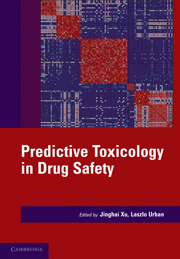Book contents
- Frontmatter
- Contents
- Contributors
- Prologue – Predictive toxicology: a new chapter in drug safety evaluation
- PREDICTIVE TOXICOLOGY IN DRUG SAFETY
- I SPECIFIC AREAS OF PREDICTIVE TOXICOLOGY
- II INTEGRATED APPROACHES OF PREDICTIVE TOXICOLOGY
- 10 Integrated approaches to lead optimization: improving the therapeutic index
- 11 Predictive toxicology approaches for small molecule oncology drugs
- 12 Mechanism-based toxicity studies for drug development
- 13 Fish embryos as alternative models for drug safety evaluation
- 14 The role of genetically modified mouse models in predictive toxicology
- 15 Toxicogenomic and pathway analysis
- 16 Drug safety biomarkers
- 17 Application of TK/PD modeling in predicting dose-limiting toxicity
- 18 Prediction of therapeutic index of antibody-based therapeutics: mathematical modeling approaches
- 19 Vaccine toxicology: nonclinical predictive strategies
- Epilogue
- Index
- Plate section
- References
14 - The role of genetically modified mouse models in predictive toxicology
from II - INTEGRATED APPROACHES OF PREDICTIVE TOXICOLOGY
Published online by Cambridge University Press: 06 December 2010
- Frontmatter
- Contents
- Contributors
- Prologue – Predictive toxicology: a new chapter in drug safety evaluation
- PREDICTIVE TOXICOLOGY IN DRUG SAFETY
- I SPECIFIC AREAS OF PREDICTIVE TOXICOLOGY
- II INTEGRATED APPROACHES OF PREDICTIVE TOXICOLOGY
- 10 Integrated approaches to lead optimization: improving the therapeutic index
- 11 Predictive toxicology approaches for small molecule oncology drugs
- 12 Mechanism-based toxicity studies for drug development
- 13 Fish embryos as alternative models for drug safety evaluation
- 14 The role of genetically modified mouse models in predictive toxicology
- 15 Toxicogenomic and pathway analysis
- 16 Drug safety biomarkers
- 17 Application of TK/PD modeling in predicting dose-limiting toxicity
- 18 Prediction of therapeutic index of antibody-based therapeutics: mathematical modeling approaches
- 19 Vaccine toxicology: nonclinical predictive strategies
- Epilogue
- Index
- Plate section
- References
Summary
OVERVIEW
Introduction
Genetically modified mouse models (genetically engineered mice, GEMs), a standard tool in biology for many years, are increasingly used in toxicology studies. At an early stage of pharmaceutical discovery and development, GEMs are used to validate novel targets. If safety issues emerge later, GEMs are widely used for mechanistic investigations to determine if the liability is on or off target. Newer models now incorporate specific human genes into the mouse system to better predict toxicities that are relevant to humans. GEMs have also been developed to enhance the rate of carcinogenesis, facilitating mouse carcinogenesis studies that can be done in six months instead of two years.
Importance of mouse strains and background genetics
One complication of GEMs is that the phenotype is often due to the interaction of many genes and is therefore strain dependent. A knockout in one strain of mice may have a specific phenotype, yet the same knockout in another strain may have a different phenotype. Differences among strains with the same knocked-out gene are particularly notable with phenotypes that are polygenic, such as diabetes mellitus. For example, mice that are heterozygous for knockout of both the insulin receptor and the insulin receptor substrate-1 (IRS-1) on a C57Bl/6J genetic background have a high incidence of diabetes (85 percent at 6 months of age), whereas those on a 129Sv background do not become diabetic.
- Type
- Chapter
- Information
- Predictive Toxicology in Drug Safety , pp. 269 - 283Publisher: Cambridge University PressPrint publication year: 2010



